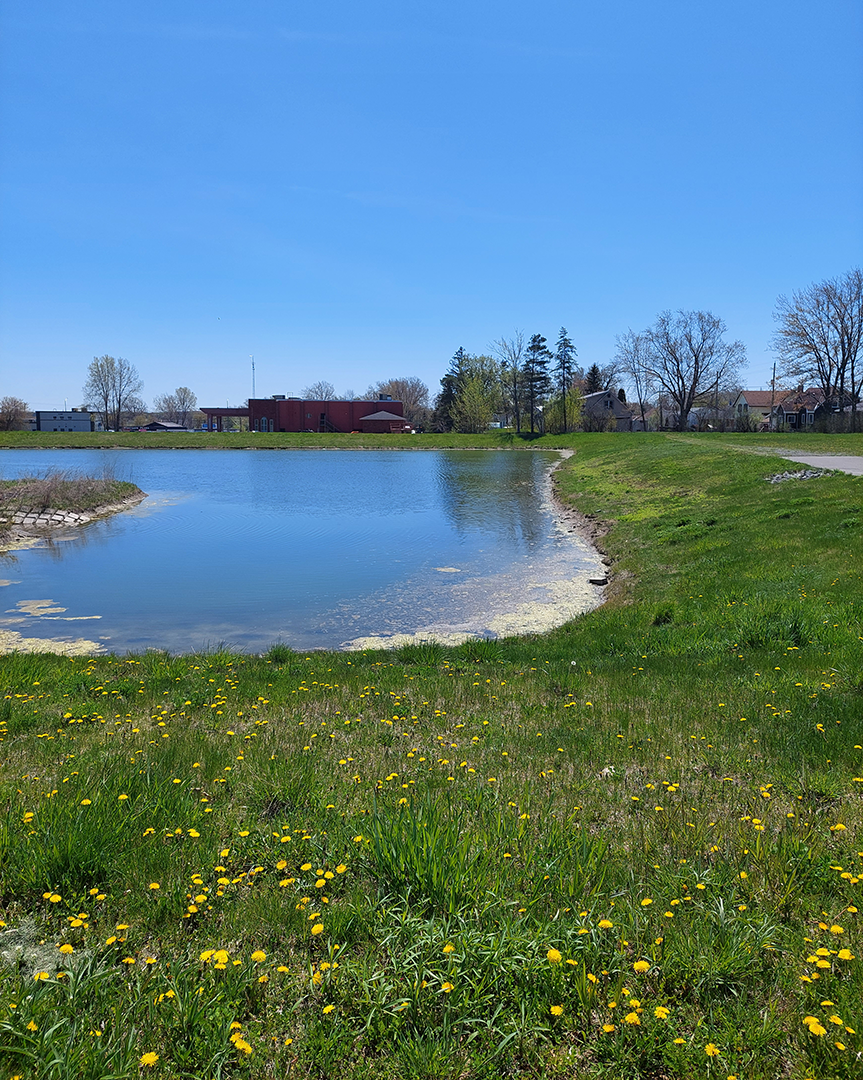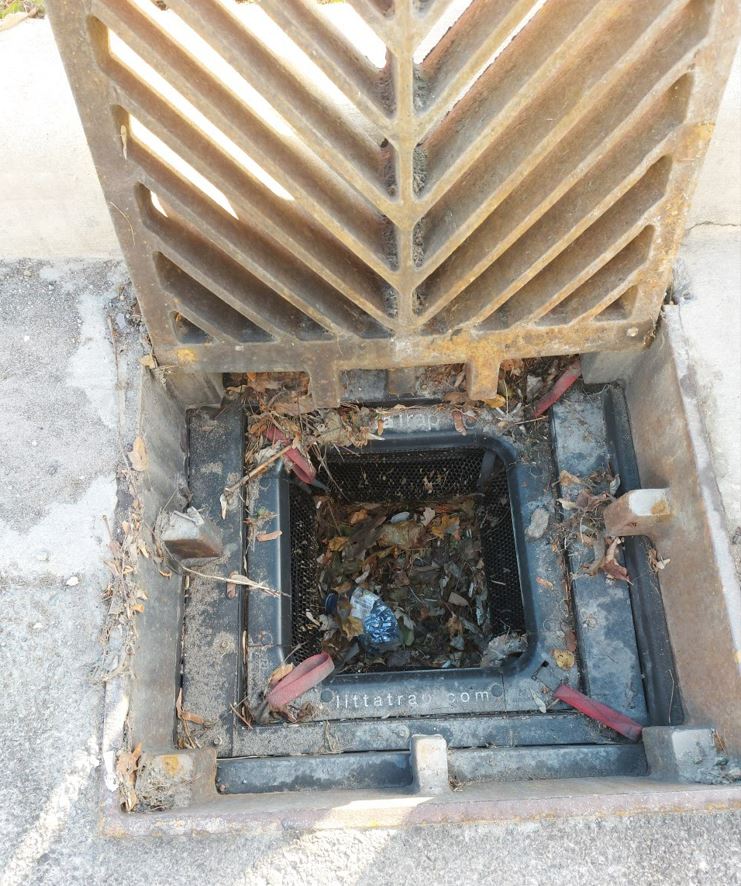The City of Belleville is responsible for the collection and management of stormwater on municipal roadways and allowances.
What is stormwater?

Stormwater is rainfall and melting snow that soaks into the ground or runs off surfaces into storm sewers and nearby waterways. As cities grow, natural landscapes are turned into roads, sidewalks, driveways, parking lots and buildings. These man-made surfaces do not allow water to soak into the ground which leads to increased stormwater runoff. As it flows over these surfaces, stormwater picks up dirt, road salts, garbage and pollutants like fertilizers, pesticides and oil and carries this pollution downstream. In traditional catch basins, these items will fall through storm grates and rush through the City’s storm drain system ending up in nearby waterways like the Moira River and Bay of Quinte – our source of drinking water in the City of Belleville and home to many fish and plant species and other wildlife. To lower the risk of flooding and protect water quality, cities use a variety of practices and technologies to manage stormwater.
How we manage stormwater
In Belleville, there are many pathways that stormwater can follow before entering a body of water. These pathways can help lower the number of contaminants that end up in our lakes and rivers.
Storm sewers
Stormwater drains, or “catch basins”, are the manholes and grates found along most roadways that collect and carry stormwater from drains through underground pipes passing through the city where it is eventually emptied into local lakes and rivers. Catch basins are designed to capture garbage, sand and gravel, but do not prevent fuels or other spilled or dumped liquids from reaching our water bodies.
When pollutants such as cooking oil or other chemicals are dumped down these drains – whether intentionally or not – they are picked up by stormwater and can be transferred to our waterways or even to our groundwater. This means that if waste oils or dirty water are poured into a catch basin in areas of the city without stormwater treatment, they are essentially being poured directly into our waterways. This degradation of water quality can lead to a decline in plant and animal diversity, and may also affect drinking water supplies and recreational water uses, such as swimming.
Residents who see illegal waste dumping or notice spills should report their observations to Ontario’s Spills Action Centre online or by phone at 1-866-MOE-TIPS, 24 hours a day, seven days a week.
Stormwater management facility
In some areas of the city, stormwater flows from the storm sewer into a stormwater management facility (e.g.. stormwater pond). There are many types of facilities, including:
- Dry ponds designed to have enough retention time to allow the stormwater to seep into the ground, and;
- Wet ponds designed to slow the flow down to a point where solid materials can settle out before the stormwater is released to our waterways.
- Oil and grit separators - In some areas of the city, stormwater flows through oil and grit separators. These underground tanks have multiple chambers that capture and remove oils, grease and sediments resulting in cleaner water downstream. Our oil and grit separators are inspected every year to determine if cleaning is required and are emptied as needed to help keep these substances out of our waterways.
Protecting our waterways
The City is doing what it can to mitigate the impacts of pollution in our stormwater system in a variety of ways, including new and innovative projects and initiatives. Learn more about these initiatives:
|
Improving Wastewater and Stormwater Discharges in Lake Ontario Program |
|
Under the province’s Improving Wastewater and Stormwater Discharges in Lake Ontario Program, the City received funding to support water and wastewater projects. Thanks to the program, the City will be better equipped to clean sediment from storm sewers and waterways, as well as to fix and maintain the stormwater management ponds used to remove contaminants like grit, excess nutrients, metals and more. |
|
Stormwater Infrastructure Maintenance and Inspections |
|
The City has implemented a program for maintaining aging stormwater infrastructure. Among the work being done for these structures, an annual cleanout and repair to stormwater ponds will also be performed to ensure ongoing removal of contaminants and control large volumes of runoff that can otherwise contribute to urban flooding.
Staff complete regular inspections of facilities to ensure they are functioning properly – controlling the flow of urban runoff, removing pollutants from stormwater, and reducing downstream erosion and other environmental impacts. |
|
Stormwater Runoff Management |
|
Belleville manages stormwater runoff through an Environmental Compliance Approval in accordance with specific rules and standards set by the Ministry of the Environment, Conservation and Parks. |
|
Bay of Quinte Remedial Action Plan and Quinte Conservation Collaborations |
|
The City of Belleville has collaborated with the Bay of Quinte Remedial Action Plan (BQRAP) and Quinte Conservation on several projects to improve stormwater management in older, existing urban areas including the Herchimer Avenue and Foster Avenue design and assessment projects, as well as the 2011 Pollution Prevention and Control Plan. |
|
Permeable Pavement |
|
When rain or snow melt hit standard parking lot materials, this water is unable to seep into the ground the way it naturally would on other natural surfaces like sand or grass. Permeable pavement helps to restore natural infiltration to the landscape by allowing water to get into the ground, while also filtering out some of the contaminants in the stormwater as it travels through the gravel sub-base and into the native soil underneath. In 2021, the City developed a pilot permeable paving parking area made from Ecoraster at Stanley Park to restore water balance and reduce runoff. Visitors to the park may learn more about permeable pavement via an educational sign at the parking lot. |
|
Street Sweeping and Catch Basins |
|
Regular maintenance of our storm sewer system is crucial in protecting the quality of our lakes and rivers. This is why we conduct street sweeping and catch basin cleaning to limit the number of contaminants carried downstream. |
|
In 2021, the Green Task Force initiated a pilot project with the City’s Environmental Services department to install three LittaTraps™ along the Riverfront and Waterfront trails to prevent pollution from reaching our waterways. Throughout the course of a year, 13.5 Kg of litter captured and diverted from the Moira River. Thanks to the Ministry of Environment and Parks’ Great Lakes Local Action Fund, the City has since expanded the program to include an additional 17 LittaTraps targeting areas of high traffic that drain directly into the Moira River. |
What you can do to help
Each of us have a role to play in helping to reduce stormwater pollution. The City recognizes the importance of protecting waterways through harm reduction strategies in stormwater, and works to acknowledge and address these issues. But what are some things that you can do to help too?
Reduce stormwater pollution
The Bay of Quinte is our primary source of drinking water in Belleville. To protect the bay, you can reduce stormwater pollution by taking these simple actions:
- Never pour anything into a catch basin
- Throw pet waste in the garbage
- When possible, wash your car at a carwash connected to a sanitary sewer
- Check your vehicle regularly for fluid leaks
- Minimize the use of lawn fertilizer and pesticides or avoid their use altogether, where possible
- Report illegal waste dumping or spills to Ontario’s Spills Action Centre online or by phone at 1-866-MOE-TIPS
Restore the natural water cycle
In natural landscapes, stormwater soaks into the ground and nourishes plants and replenishes nearby waterways and aquifers. You can help restore this natural cycle on your own property. Reduce stormwater runoff and prevent basement flooding and foundation repairs with the following options best suited to your home and lifestyle.
|
Rain Gardens |
|
Rain gardens are specially constructed gardens found in low areas of a yard where stormwater is collected and then naturally filtered by plants and soil. Interested in building your own rain garden? To learn how, check out Greening Your Grounds - a webinar created by the Bay of Quinte Remedial Action Plan (BQRAP). BQRAP is also offering grants up to $750 for eligible residents under their landowner stewardship program to cover the costs of native plants, soil, compost, gravel and mulch to establish a functioning rain garden. |
|
Rainwater Harvesting |
|
Rainwater harvesting is the practice of collecting rainwater from a roof or other surface and saving it for later use. At its simplest, rainwater harvesting consists of a rain barrel placed under the downspout of your home to collect rainwater for garden irrigation, however there are many other ways to harvest rainwater for use in your home and garden. To discover more about rainwater harvesting, check out these resources: |
| Rain Barrels |
| Installing rain barrels on your property is a simple way to capture rainwater on your property. They can be purchased from local hardware stores or through fundraising efforts by local organizations. |
Stormwater Performance Reporting
The Ministry of the Environment, Conservation and Parks modernized its approach to the Environmental Compliance Approval application process, creating the Consolidated Linear Infrastructure Environmental Compliance Approval. The reports below meet the requirements of this new process.
The annual reports summarize the operational performance of the City of Belleville’s stormwater management system.
Hardcopies of these reports are available at the City's Operations Centre at 31 Wallbridge Cres. If you have any further questions, please contact the City of Belleville at 613-968-6481.


 To mitigate impacts of litter in our stormwater system, the City has installed an
To mitigate impacts of litter in our stormwater system, the City has installed an